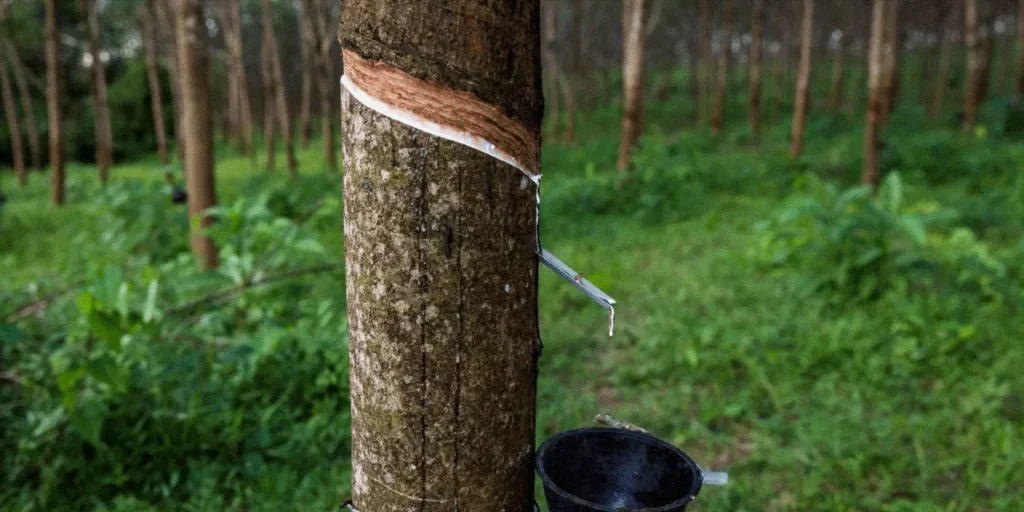The government has increased funding by 23% to Rs 708.7 crore for the scheme “Sustainable & Inclusive Development of Natural Rubber Sector,” aimed at enhancing the cultivation and quality of rubber crops in India.
About the recent move:
- It will help to increase the area under cultivation of the rubbercrop, as India has to heavily depend on imports for rubber.
- With the increase in finance, the 5-year allocation for the scheme is Rs 999.86 crore.
- The funds will be used to support the plantation of rubber, generation of planting material, productivity enhancement, formation of rubber producers’ societies, and rubber research and training.
- 3 nodal centres of the National Institute of Rubber Training (NIRT) will be established in North East region including Agartala, Guwahati and Nagaland in the next 2 years.
About the Sustainable & Inclusive Development of Natural Rubber Sector:
- It provides subsidies to bring new regions under plantation, replanting old plantations, buying new equipment’s for cultivation, research, modernization of existing setup, formation of farmer clusters, improving the quality of life of workers, and latex collection among others.
- It runs parallel with the tenure of the award of the 15th Finance Commission.
- It is implemented by the Rubber Board.
Financial support by scheme:
- To support the rubber industry, planting of rubber will be undertaken in 12,000 ha in traditional areas during 2024-25 and 2025-26 with an outlay of Rs 43.50 crore.
- To achieve this, the rate of assistance has been increased to Rs. 40,000 per ha.
- 3752 ha will be brought under rubber cultivation in non-traditional regions during 2024-25 and 2025-26.
- These plantations are in addition to the Rubber Board’s INROAD project carried out in the North East.
- Sponsored nurseries will be promoted by the Board in non-traditional areas for generating good quality planting material.
- Additional Group Processing Centres (GPC) will be set up to ensure quality and standardization of rubber sheets.
- Rubber clones that are suitable to different agro-climatic regions of India, will be developed.
- It will promote forums of smallholders of rubber through Rubber Producers Societies (RPS), by supporting its formation.
- Assistance will also be provided for equipment to producer organisation.
- Funds for welfare measures includes- Educational Stipend, Women empowerment schemes, Assistance for House construction, Group Life Insurance cum Terminal Benefit, Personal Accident Insurance Scheme and pension scheme for the next 2 years.
About Rubber Crop:
- Also known as Hevea brasiliensis, it is a tropical tree that is cultivated on plantations in the tropics and subtropics, on laterite soil, mostly in slope and undulated land.
- It is an equatorial crop, but under special conditions, it is also grown in tropical and sub-tropical areas.
- It requires a moist and humid climate with rainfall of more than 200 cm. and temperature above 25°C.
- Rubber is an important industrial raw material.
- It is mainly grown in Kerala, Tamil Nadu, Karnataka and Andaman and Nicobar Islands and the Garo hills of Meghalaya.
- In 2010-11 India ranked fourth among the world’s natural rubber producers.
About Rubber Board:
- The Rubber Board is a statutory body established under the Rubber Act of 1947 by the Government of India.
- Its primary purpose is to oversee and promote the comprehensive development of the rubber industry in the country.
- The Head Office of the Rubber Board is situated in Kottayam, Kerala.
Historical Context:
- Commercial cultivation of natural rubber in India began with British initiatives, with experimental efforts dating back to 1873 in Calcutta.
- During World War II, the strategic importance of rubber production for India’s security was realized, leading to increased cultivation.
- Post-war, a government committee recommended the establishment of a permanent organization, resulting in the enactment of the Rubber (Production and Marketing) Act, 1947.
- The Rubber Board, initially formed under this act, was later renamed through the Rubber (Production and Marketing) (Amendment) Act of 1954.
Legislative Framework:
- The Rubber Board operates within the framework of legislative enactments, including the Rubber Act of 1947 and subsequent amendments.
- Key amendments include the Rubber (Production and Marketing) (Amendment) Act of 1954, the Rubber (Amendment) Act of 1960, and the Rubber (Amendment) Act of 1982.
- Legislative changes have defined the role of the Board and provided for the appointment of a Chairman and an Executive Director.
Functions:
- Promote Development: Facilitate the overall development of the rubber industry through strategic measures.
- Research and Training: Undertake or assist scientific, technological, and economic research while training students in modern cultivation methods.
- Technical Guidance: Provide technical advice to rubber growers to enhance productivity and quality.
- Marketing Improvement: Work towards improving the marketing of rubber products.
- Data Collection: Collect statistics from estates, dealers, and manufacturers for informed decision-making.
- Worker Welfare: Ensure better working conditions and incentivize workers in the rubber industry.
- Advisory Role: Advise the Central Government on industry-related matters, including import/export, and contribute to international conferences or schemes.
- Reporting: Submit regular reports to the Central Government on activities and industry status as mandated by the Rubber Act.
Key Facts:
- India needs 13.5 lakh tonnes of natural rubber, but the local production of natural rubber is just 8.39 lakh tonnes.
Ref: Source
| UPSC IAS Preparation Resources | |
| Current Affairs Analysis | Topperspedia |
| GS Shots | Simply Explained |
| Daily Flash Cards | Daily Quiz |


